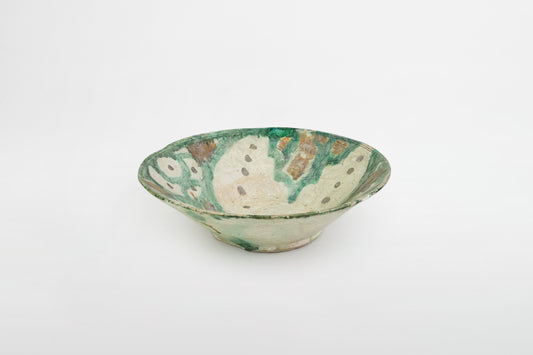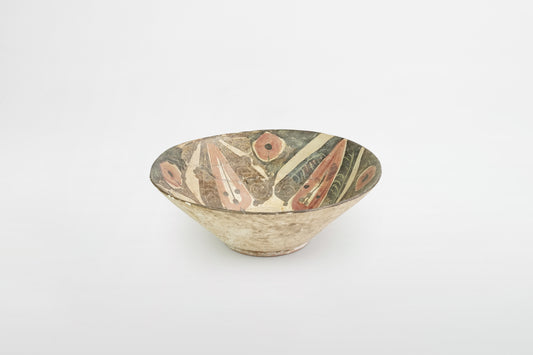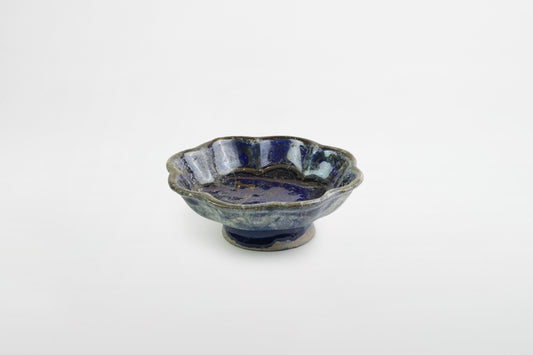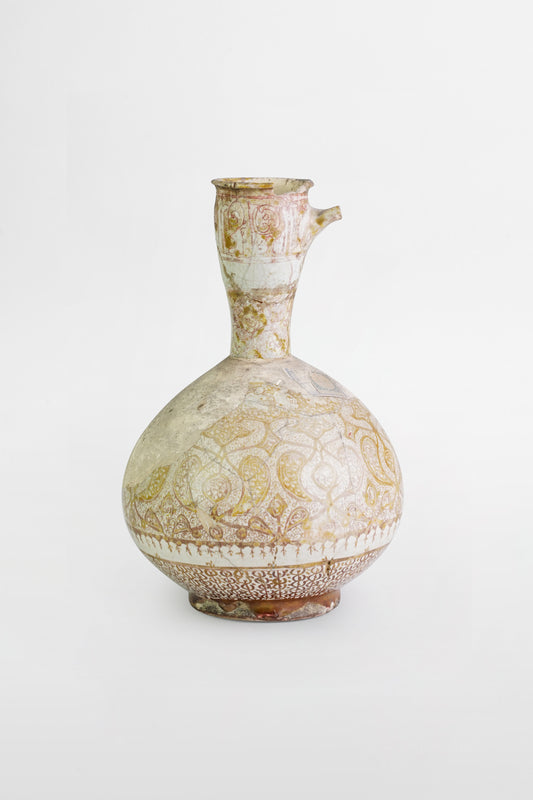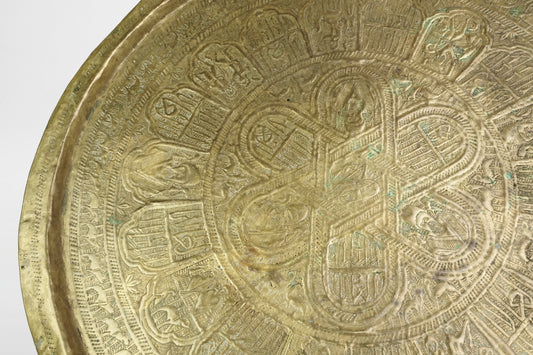Collection: Islamic Art
Geometry, Devotion, and Calligraphy – Islamic Art Across Centuries
This collection of Islamic art offers a journey through more than a thousand years of aesthetic and spiritual refinement, spanning regions from Persia to Syria and beyond. The selection includes ceramic bowls, lusterware, and finely engraved metalwork from the 10th to the 19th century—objects once created for princely courts, domestic interiors, and religious settings.
A particular focus lies on Samanid ceramics from northeastern Iran, especially those from the city of Nishapur. These vessels display bold calligraphic designs in kufic script, stylized animal and plant motifs, and vibrant color contrasts on creamy white slips. The visual language is both rhythmic and symbolic, blending functionality with poetic ornament.
Another highlight is Kashan lustreware from the 12th and 13th centuries—ceramics with shimmering metallic surfaces, often decorated with figural scenes, inscriptions, or intricate geometric compositions. These works reflect a high point of technical and artistic innovation during the Seljuk and Ilkhanid periods.
Engraved bronzes from Seljuk and Mamluk workshops (12th–16th centuries) round out the collection, demonstrating the technical sophistication of Islamic metalwork. Inlaid with silver or gold, these objects—inkwells, ewers, and bowls—feature both utilitarian purpose and elaborate ornament, including epigraphic bands, astrological imagery, and vegetal scrollwork.
These works reflect the diversity of Islamic artistic production and the rich exchange of ideas, techniques, and iconography across dynasties, trade routes, and religious traditions. They offer a glimpse into a world where craftsmanship was a form of devotion, geometry a visual philosophy, and calligraphy a sacred art.
Read less-
Samanid glazed ceramic bowl – Persia, 10th century
Regular price €8.000,00Regular priceUnit price / per -
Samanid glazed ceramic bowl – Persia, 10th century
Regular price €3.400,00Regular priceUnit price / per -
Glazed ceramic bowl with dipiction of a horse, Nishapur – Persia, 12th century
Regular price €5.000,00Regular priceUnit price / per -
Glazed ceramic bowl, Nishapur – Persia, 12th century
Regular price €1.600,00Regular priceUnit price / per -
Glazed ceramic bowl, Nishapur – Persia, 12th century
Regular price €1.600,00Regular priceUnit price / per -
Glazed ceramic bowl from Nishapur – Persia, 10th century
Regular price €7.000,00Regular priceUnit price / per -
Samanid ceramic bowl with calligraphic decoration – Persia, 10th century
Regular price €5.500,00Regular priceUnit price / per -
Samanid glazed ceramic bowl – Persia, 9th/10th century
Regular price €1.600,00Regular priceUnit price / per -
Samanid glazed ceramic bowl – Persia, 10th century
Regular price €5.000,00Regular priceUnit price / per -
Samanid glazed ceramic bowl – Persia, 10th century
Regular price €5.000,00Regular priceUnit price / per -
Samanid ceramic bowl – Persia, 8th century
Regular price €200,00Regular priceUnit price / per -
Samanid ceramic bowl – Persia, 8th century
Regular price €400,00Regular priceUnit price / per -
Ilkhanid glazed bowl, Kashan – Persia, 14th century
Regular price €880,00Regular priceUnit price / per -
Lustre pottery bottle, Kashan – Persia, early 13th century
Regular price €5.500,00Regular priceUnit price / per -
Ilkhanid faience ceramic carafe from Kashan – Persia, 14th century
Regular price €1.900,00Regular priceUnit price / per -
Ilkhanid faience glazed bowl, Kashan – Persia, 14th century
Regular price €1.200,00Regular priceUnit price / per -
Lustre pottery bottle, Kashan – Persia, early 13th century
Regular price €1.600,00Regular priceUnit price / per -
Ceramic carafe – Andalusia, 14th century
Regular price €2.500,00Regular priceUnit price / per -
Porcelain bowl – Persia, 19th century
Regular price €500,00Regular priceUnit price / per -
Seljuk glass wine vessel – Persia, 12th century
Regular price €5.500,00Regular priceUnit price / per -
Glass carafe – Northeast Persia, Ghaznavid dynasty, 10th century
Regular price €1.200,00Regular priceUnit price / per -
Seljuk glass bowl – Persia, 10th/11th century
Regular price €800,00Regular priceUnit price / per -
Seljuk dark patinated bronze ewer with engravings – Northeast Persia, 12th century
Regular price €6.000,00Regular priceUnit price / per -
Seljuk bronze inkwell – Persia, 12th century
Regular price €7.000,00Regular priceUnit price / per -
Ilkhanid brass candlestick base – Persien, 14th century
Regular price €5.000,00Regular priceUnit price / per -
Seljuk patinated bronze candle holder, Nishapur – Persia, 12th century
Regular price €3.400,00Regular priceUnit price / per -
Safavid tinned copper bowl – Persia, 17th century
Regular price €3.000,00Regular priceUnit price / per -
Astrological instrument from the Mughal dynasty, possibly Lahore – West India, 18th century
Regular price €5.500,00Regular priceUnit price / per -
Engraved brass plate for low tea table – Egypt, 19th century
Regular price €700,00Regular priceUnit price / per




